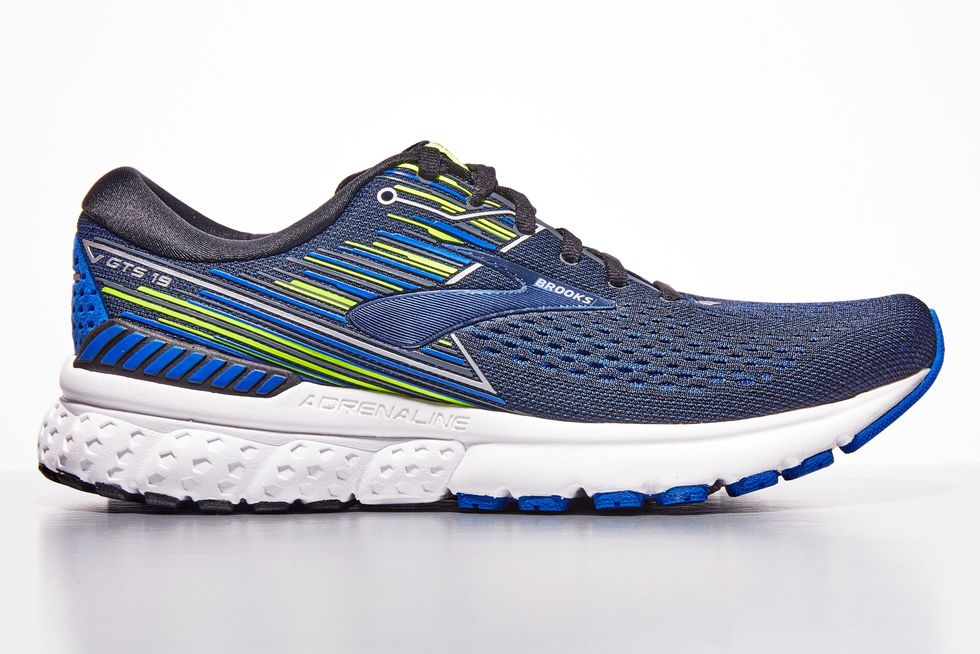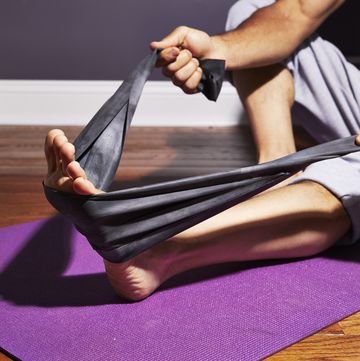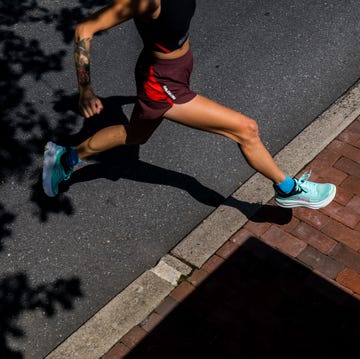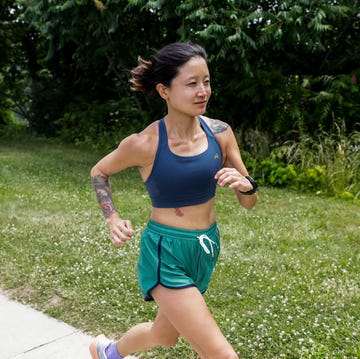Price: $130
Weight: 11.1 oz (M), 9.2 oz (W)
Type: Road
The right shoe for: When you need stability—and want fresh legs post-long run
Buy Men’s Buy Women’s More Images
In late summer, Brooks announced their newest endeavor: updating the Adrenaline GTS to use guide rails for stability. The previous model used a medial post that Brooks called a Progressive Diagonal Rollbar, which was introduced back in ’03. Replacing the support system of the most beloved of Brooks’s stability shoes (we’ve given it 10 awards in its 20-plus year history) is a daring, one might even say risky, move.
Guide rails are a more holistic approach to stability; using a bowling analogy, imagine your foot as the ball and the shoe’s guide rails as the bumpers. This means no arch-poking medial post. By “bumpering” foot movement, the knee experiences less stress, which will hopefully prevent knee injuries. This new system makes the Adrenaline accessible to pronators and neutral runners alike, since the guide rails aren’t disruptive if you don’t bump up against them.
It’s too early to tell if the 19th iteration will decrease knee injuries—at least within a month of testing—but there are several other traits we loved about the latest Adrenaline GTS. First, it feels shockingly lightweight on runs—despite our shoe lab finding it on the heavy end of the shoe spectrum. Second, the moderate cushioning provides a soft ride for Clydesdales, yet has enough give to satisfy runners on the lighter side, as well. And finally, our tired legs did not feel beat up when we ran long in the shoe.
Supportive Midsole
The midsole is a combination of BioMoGo DNA and Brooks’s new DNA Loft crash pad, which is located in the heel. DNA Loft is a blend of foam, air, and rubber; the latter increases durability and hinders cushioning from diminishing due to overuse. Because of the implementation of DNA Loft, Adrenaline 19 is firmer than its predecessor—at least, according to shoe lab scores. We reveled in the firm but not-too-firm cushioning of the midsole; wear-testers reported legs that weren’t too weary, nor beat up, post-long runs.
Durable Rubber Outsole
We did a lot of wear-testing of the Adrenaline during a particularly rainy fall in Pennsylvania, where the shoe performed flawlessly. On wet pavement and leafy sidewalks, the Adrenaline did not slip nor slide. There was also no issue with durability; the rubber outsole showed little-to-no signs of wear over our testing period.
Looks Fast
The engineered mesh, 3D print upper gives the shoe a fast look and comfy, true-to-size fit. A minor caveat is the shoe’s tendency to soak up water on rainy runs. Several wear-testers listed this drawback as their only complaint about the Adrenaline—yet declared this trait wasn’t a deal breaker.
What Our Wear Testers Say
Kristen R., tester since 2018
Arch: High | Gait: Neutral | Footstrike: Heel
“The cushioning in the Adrenaline complimented my high arch, yet the weight did not feel heavy. I liked that the shoe continued to absorb the hard road surface and maintained its comfort. It felt similar running on a treadmill surface.”
Diane L., tester since 2017
Arch: High | Gait: Overpronator | Footstrike: Forefoot
“The Adrenaline felt lighter and more flexible, without sacrificing the cushioning and pronation control. My feet don’t feel tired or beat up after running on hard surfaces, or slightly rocky ones, for an extended period of time.”
All the Stats You Need!
Men’s
- Weight: Very Heavy | 11.1 oz
- Heel-To-Toe-Drop: Very High | 12.5 mm
- Heel Height: Very High | 36.6 mm
- Heel Cushioning: Moderate
- Forefoot Height: High | 24.1 mm
- Forefoot Cushioning: Soft
- Flexibility: Very Stiff
- Stability Features: Some
- Energy Return: More
Women’s
- Weight: Very Heavy | 9.2 oz
- Heel-To-Toe-Drop: High | 10.6 mm
- Heel Height: High | 32.9 mm
- Heel Cushioning: Moderate
- Forefoot Height: Moderate | 22.3 mm
- Forefoot Cushioning: Moderate
- Flexibility: Very Stiff
- Stability Features: Some
- Energy Return: More
We put each shoe through real-world usage and a battery of mechanical tests in our lab to provide you with objective—and exclusive—data. In addition to measuring a shoe’s weight, we measure sole thickness (everything that sits between your foot and the road), how well the foam cushions your stride, and the flexibility of the forefoot. All this is taken into account in our reviews of each shoe.
Amanda Furrer, Editor, Running Reviews, studied journalism at NYU and writing at Emerson College. She has reviewed gear and covered other topics in the running space for almost 10 years. Since 2013, she has consecutively run the Boston Marathon. She also has a master’s degree in gastronomy from Boston University and was formerly a professional baker for two years before hanging up her apron.
















